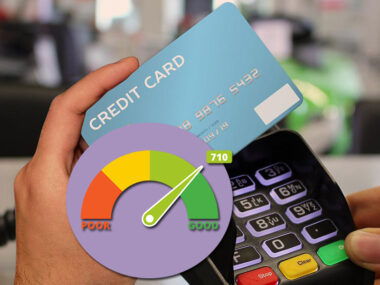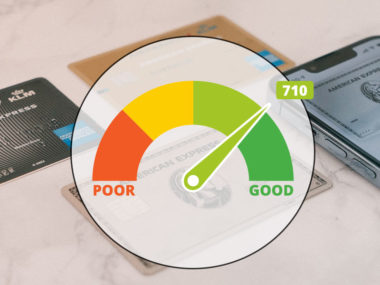A FICO credit score of 560 is classified as being “Very Poor” by credit bureaus Experian, TransUnion, and Equifax. It falls well below the average credit rating, making it difficult to obtain a credit card or secure a loan with a reasonable interest rate and terms.
Home and auto lenders often include high interest rates and fees for borrowers with credit scores as low as 560. Credit card companies also typically add stiff fees or require large deposits from an applicant with a low credit rating. A security deposit is often needed to start utility company service and access the proper equipment.
Table of Contents
Why Your Credit Score Is 560
Many contributing factors can lead to a “Very Poor” 560 credit score. Some reasons have more influence than others in calculating your rating. The influencing factors that determine your FICO score include:
- Payment history (35%);
- Outstanding debt (30%);
- Credit history length (15%);
- New credit (10%);
- Current credit types in use (10%);
Prior issues with paying back loans and other debt negatively affect your credit score and borrowing power. The following issues may contribute to receiving a 560 credit score.
Debt Default and Delinquency
Getting behind on payments or defaulting on a loan are leading indicators to lenders that you are a financial risk. Continued payment delays wind up costing you more money and causing additional damage to your credit score.
The types of accounts that impact your credit score may include:
- Major Credit Cards;
- Retail Credit Cards;
- Loans;
- Finance Accounts;
- Home Loans;
Solution: Making payments towards delinquent or defaulted accounts is the best way to satisfy creditors and remove negative marks against your credit rating. Even if you cannot pay off the balance at one time, making up missed payments can work to pay down the debt and help avoid collections or legal action.
Foreclosure or Repossession
Losing a home or other property due to non-payment establishes a credit history of being a high-risk borrower. If you must undergo a home foreclosure or property repossession to recover missed payments on a mortgage or loan, it will cause your credit rating to plummet.
According to FICO, borrowers with a good credit score can see a drop of 100 points or more after a foreclosure.
Solution:Repossessions and foreclosures occur only after continued non-payment and collection attempts. These leave negative marks on your rating, independent of the effect of a loan’s termination.
It will take several years of on-time payments to raise your rating and reestablish trust among lenders. Paying off a secured or unsecured credit card helps to add positive activity to your monthly credit reports.
Bankruptcy
Filing for bankruptcy is a legal proceeding that allows full or partial relief for people with significant debt. However, bankruptcy also comes with the most severe consequences to your credit rating. Bankruptcy can reduce even the highest scores by hundreds of points that can take up to a decade to retrieve.
Solution:With court approval, opening up a secured credit card is an effective way for you to begin recovery from bankruptcy. A refundable deposit serves as your spending limit, so you can never default on a secured credit card.
Positive activity from a secured credit is reported to credit bureaus like any other credit card, pushing down prior negative marks. If you make payments on time or the card is not used at all, only positive information will be added to your credit rating.
What Can You Do With a 560 Credit Score?
A 560 credit score is not high enough to get you approved for the kind of low-interest home loan or credit card that someone with a 700 score will be able to acquire. However, there are some things you can do with a low credit score as you work to build up your rating.
Credit Card
A 560 credit score makes it difficult to get approved for a traditional credit card that comes with standard fees, financing terms, and rewards programs.
Paying off defaulted or delinquent accounts and catching up on current payments could give your credit rating the boost you need for credit card approval. Otherwise, you can try to apply for a credit card for people with bad credit to improve your credit score.
Secured Credit Card
A secured credit card is often the easiest and safest way to apply positive activity to your monthly credit reports. A required deposit is also your spending limit, so you can never overspend or accumulate excessive bills.
Whether you make timely payments for purchases or do not use the card at all, a secured credit card offers some financial flexibility while increasing your credit score.
Retail Credit Card
Store credit cards often come with limitations on purchases and rewards benefits. The restrictions placed on retail credit cards make someone with a 560 credit score less of a risk. Be prepared to be strapped with higher interest rates and stricter limits on branded purchases and rewards.
Home Loan
A 560 credit score falls below the bare minimum rating needed to qualify for a standard mortgage from a traditional home lending institution.
If you have a “Very Poor” credit score. you may be eligible for government-sponsored home mortgage financing programs through the Federal Housing Administration (FHA) or a VA Loan if you are an active service member or veteran of the U.S. military.
Car Loan
An auto loan and insurance premiums with reasonable rates are tough to find with a 560 credit score. Car dealers are often willing to sell you a vehicle, but it will come with a far higher annual percentage rate (APR) and will cost you more money over the term of the loan.
Waiting to purchase a vehicle until you have put in the work to improve your credit rating will allow you to buy a better car for less money.
Personal Loans
Getting a personal loan with a 560 credit score may also be difficult, but there are long-term personal loan options for people with bad credit. Lending organizations like CashUSA.com and CashAdvance.com offer loans that come with varying amount limits, terms, and interest rates.
Home or Apartment Rental
You might be able to rent a house or apartment with a 560 credit rating, though it will likely come with a higher security deposit. Signing up for utility services will also require additional deposits to get started.
How to Repair a 560 Credit Score
Having a 560 credit score restricts your borrowing and purchasing power, placing limitations on your preferred lifestyle. However, there are specific things you can do to repair your credit rating and improve your financial health.
Pay Your Bills on Time
Among the first things a lender will look at is how reliable you are at paying your bills on time and keeping account balances manageable. Your payment history is an indicator of how big a risk you are as a borrower.
Paying bills on time and chipping away at old debt at the same time will show an effort to get your finances under control and an ability to handle future payments.
Pay Down Your Credit Card Debt
Your credit utilization ratio compares the total of your debt to the amount of available credit you are currently using. This ratio accounts for 30% of your credit score calculation. Paying down your credit card balances below the limit is the first step to ultimately paying off the balances and increasing your credit rating.
Avoid Applying for Too Much New Credit
Applying for multiple new lines of credit drops your credit score for loans that you likely have little chance of getting approved for anyway. Limit new credit applications to those that are likely to be successful.
Dispute Inaccurate Credit Bureau Information
Lenders trust the accuracy of the three credit bureaus, TransUnion, Experian, and Equifax, and rely on them to make decisions about your available credit. Inaccuracies and wrong information have the potential to drag your credit score down unfairly.
It is up to you to verify what is on your credit report and dispute incorrect information. Regularly monitoring your credit will allow you to discover inaccuracies before they impact your rating.
Image Source: https://depositphotos.com/





